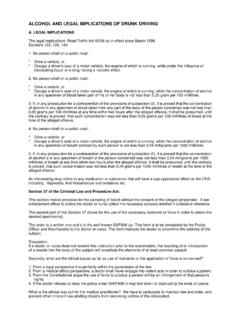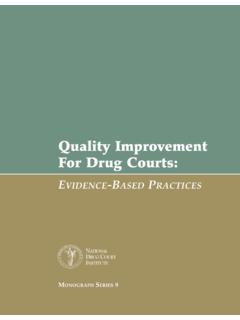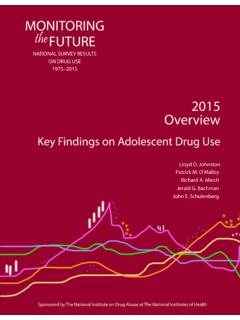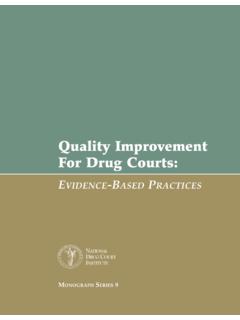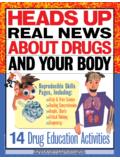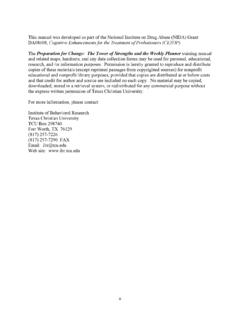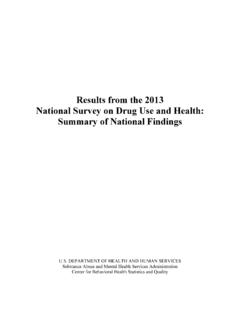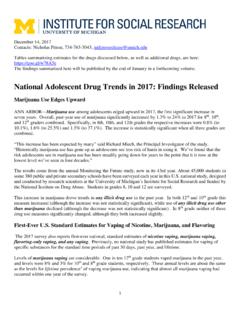Transcription of SUBSTANCE ABUSE IN SOUTH AFRICA: COUNTRY …
1 SUBSTANCE ABUSE IN SOUTH AFRICA: COUNTRY REPORTFOCUSSING ON YOUNG PERSONSP repared for the WHO/UNDCP Regional Consultation - Global Initiative onPrimary Prevention of SUBSTANCE ABUSE Among Young People, Harare, Zimbabwe, 24-26 February 1998 Charles DH Parry, PhDMental Health & SUBSTANCE ABUSE , Medical Research CouncilPO Box 19070, 7505 Tygerberg; SOUTH Fax: +27-21-938-0342 SOUTH africa report , pg. africa is the southern most COUNTRY in africa and has a population ofapproximately 38 million persons, distributed over nine provinces ranging inpopulation from 746 000 (Northern Cape) to 7 672 000 (KwaZulu-Natal). It isestimated that of the population reside in urban areas (Central StatisticalServices, 1997).
2 Table 1 gives an indication of the percentage of the populationfalling in different age bands. There has been considerable controversy in SouthAfrica with regard to what constitutes a young person, with the Youth League of theAfrican National Congress for example, allowing into membership persons up to 35years of age. Regardless of ones definition of what constitutes a young person it isclear from Figure 1 that at least half the population of SOUTH africa can probably becategorised as young people .Law enforcement authorities, service providers and SUBSTANCE ABUSE researchersare in agreement that the nature and extent of illicit drug trafficking, consumptionand associated problems have all increased dramatically during the 1990s as thecountry has gone through a major political and social transformation and as tradeand other links have open up with other African countries and the rest of the change with regard to substances such as alcohol and tobacco has been lessdramatic, but due to the enormous burden to society caused by the use of thesesubstances, prevention efforts should not only be directed towards illicit report , in particular.
3 Focuses on alcohol and other drugs (AODs), and givesspecial attention to young africa report , pg. ABUSE AND RELATED HEALTH AND SOCIALPROBLEMS IN SOUTH to collect SUBSTANCE ABUSE informationHistorically SOUTH africa has not had very reliable systems in place to facilitate thecollection of data relating to SUBSTANCE use. To date, much of the ava ilableinformation has come from ad hoc cross-sectional research studies often conductedin a single location and from information on police arrests and seizures. This hasbeen supplemented by occasional national surveys. Apart from the police arrestand seizure data, which is greatly influenced by factors such as resources availableand particular policing policies and initiatives, there has been no longitudinalinformation available on trends in illicit drug use.
4 With regard to alcohol, the onlynational trend data available are (i) information on adult, per capita annual absolutealcohol consumption from 1985, (ii) information on the results of annual testing ofalcohol levels among drivers and pedestrians from 1975, and (iii) a single studycomparing consumption of absolute alcohol among different populations in 1982 and1985 (Rocha-Silva, 1989). As stated, the predominant way in which information on AOD use has beencollected in SOUTH africa has been via ad hoc research undertaken by researchersfrom one of the science councils (the Medical Research Council (MRC), the HumanSciences Research Council (HSRC) or the Council for Scientific and IndustrialResearch (CSIR)), or from universities ( Cape Town, Stellenbosch and Durban-Westville) or from NGOs ( the Centre for Alcohol & Drug Studies, the SouthAfrican National Council on Alcoholism and Drug Dependence (SANCA), theInstitute for Health Training and Development (IHTD) and the SOUTH African BrainResearch Institute (SABRI)).
5 Funding has largely come from the Centre for ScienceDevelopment, the MRC, the Department of Welfare and individual new systems have been initiated which should lead to more valid andreliable information on AOD use in future. These include:The SOUTH African Community Epidemiology Network on Drug Use (SACENDU)SACENDU is a network of persons from a variety of different sectors ( lawenforcement, health and welfare treatment services, and public health research) thatmeets biannually to present and discuss information about existing and emergingAOD ABUSE patterns and trends. The network, currently comprising over 50organisations in four sentinel sites, was established by the MRC in collaborationwith the University of Durban-Westville in 1996 with the technical assistance of theWorld Health Organization s Programme on SUBSTANCE ABUSE (WHO/PSA) and theUS National Institute on Drug ABUSE (NIDA).
6 Start up funds for SACENDU wereprovided by WHO/the United Nations Development Programme (UNDP) and theMRC. It now comprises three port cities (Cape Town, Durban and Port Elizabeth)and Gauteng Province (which includes Johannesburg and Pretoria). Indicators usedin Phase I of the SACENDU Project, together with the type of data (primary orsecondary), the data source and frequency of data collection are listed in Table africa report , pg. 4 Data sources have included specialised treatment centres, acute psychiat ricadmissions units, the police, and mortuaries. Here the focus has been on collectingsecondary data. Primary data have also been collected via qualitative research(involving sex workers, persons attending rave parties, street children andpharmacists), school surveys, and trauma unit studies (Parry, Bhana, & Bayley,1997).
7 The Crime Information Management Centre (CIMCThis centre was established in 1996 and is tasked with the coordination,processing, analysis and interpretation of crime information and intelligence in orderto facilitate the combatting of crime by means of effective and holistic crimeinformation management (CIMC, 1997). On a quarterly basis CIMC releasesnational, provincial, and district -level statistics by 32 crime categories, including drug related crime and driving under the influence of alcohol or drugs .Unfortunately data are not yet broken down by the age of the SOUTH African Alliance for the Prevention of SUBSTANCE ABUSE (SAAPSA)SAAPSA was established in 1995 with the assistance of WHO/PSA, theInternational Council on Alcohol and Addictions (ICAA), and the InternationalOrganisation of Good Templars (IOGT) and includes members from over 70organisations.)
8 Its goal is to facilitate networking amongst all organisations,government and civil society, concerned with drug and alcohol ABUSE in Sout h Africawith the view to optimise cooperation in the prevention and treatment of alcohol anddrug ABUSE in order to improve the quality of life and to promote peace anddevelopment for all SOUTH Africans (Turner, 1996, p. 7).The SOUTH African Researcher-Practitioner Association (SARPA)SARPA comprises over 50 government departments, private institutions as well asCBOs. Its vision is to sustain an inclusive multi-sectoral forum of researchers andpractitioners that facilitates community-driven research based policy formation andservice provision regarding drug-related prevention and treatment in SOUTH africa (Drug Advisory Board, 1997, p.)
9 22). The HSRC is one of the driving forces Information System for Social Welfare (NISWEL)For several years now there has been some discussion by the Department ofWelfare with regard to the development of a National Information System for SocialWelfare which among other things would include national level indicators onsubstance ABUSE treatment demand and prevention services. This system is not yetfully africa report , pg. 5 TABLE 1 SACENDU: Indicators, data sources and frequency of data collectionINDICATORTYPESOURCEFREQUENCYNA TURE AND EXTENT OF AOD USE/ABUSEP rimary SUBSTANCE of ABUSE (as well as secondarydrugs used, mode of administration, referral source,type of treatment, severity, monthly spending onAODs)2 aryAll specialist treatment centresContinuous-6 monthsATOD use1 ary1 ary2 ary-School surveys (representative sample Grades 8 and 11) -Interviews with drug users (street children, rave party attenders, commercial sex workers) & pharmacists Alcohol testing drivers/pedestrians (from CSIR)1 X per year2 X per year1 X per yearCONSEQUENCES OF AOD USEAOD-related deaths2 aryMortuary surveillance.
10 Blood alcohol & drug OD mentions (fromUCT/U Stellenbosch Forensic Medicine)Continuous-12monthsAOD arrests/seizures-Drunk driving (collision/no collision)-Dealing in drugs (arrests, units seized, price,purity)-AOD use among arrestees2 ary2 ary1 aryCrime Information Management Centre Crime Information Management Centre, SANABMRC/SANCA/Institute for Security Studies: using blood/urineanalysesContinuous-6 monthsContinuous-6 monthsTBAAOD-related trauma mentions1 aryStudy of patients 1 public hospital - 2 idealized weeks over 2months: breath (alcohol), urine/sweat (drugs)1 X per yrAOD-related psychiatric conditions2 aryReview intake/discharge information from public psychiatric facilities(alcohol/drug-related diagnoses as proportion of other diagnoses)Continuous-6 -- 12 mo.
